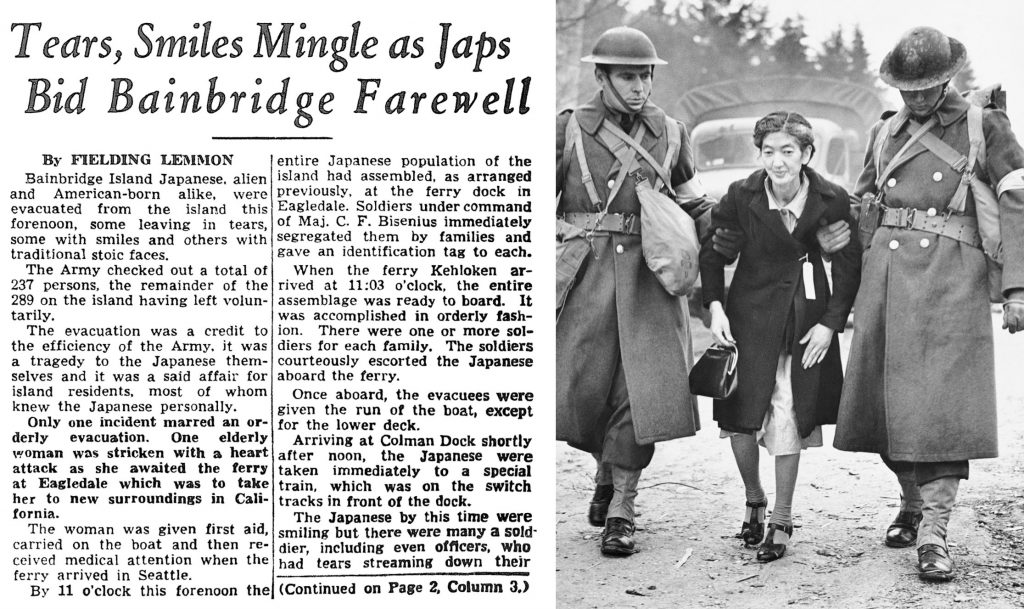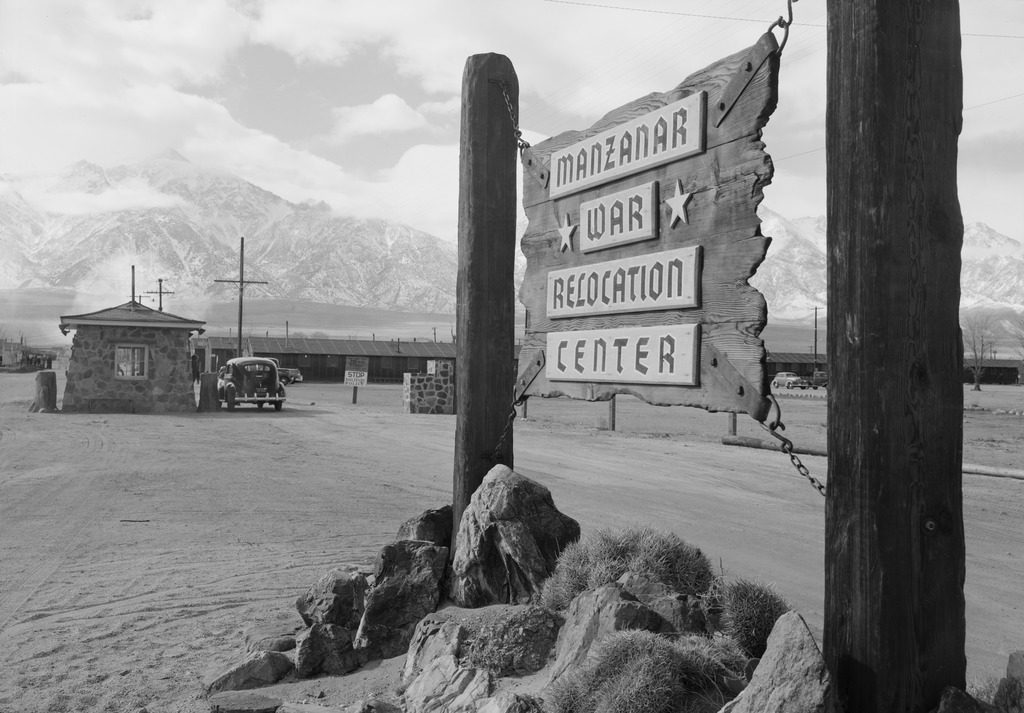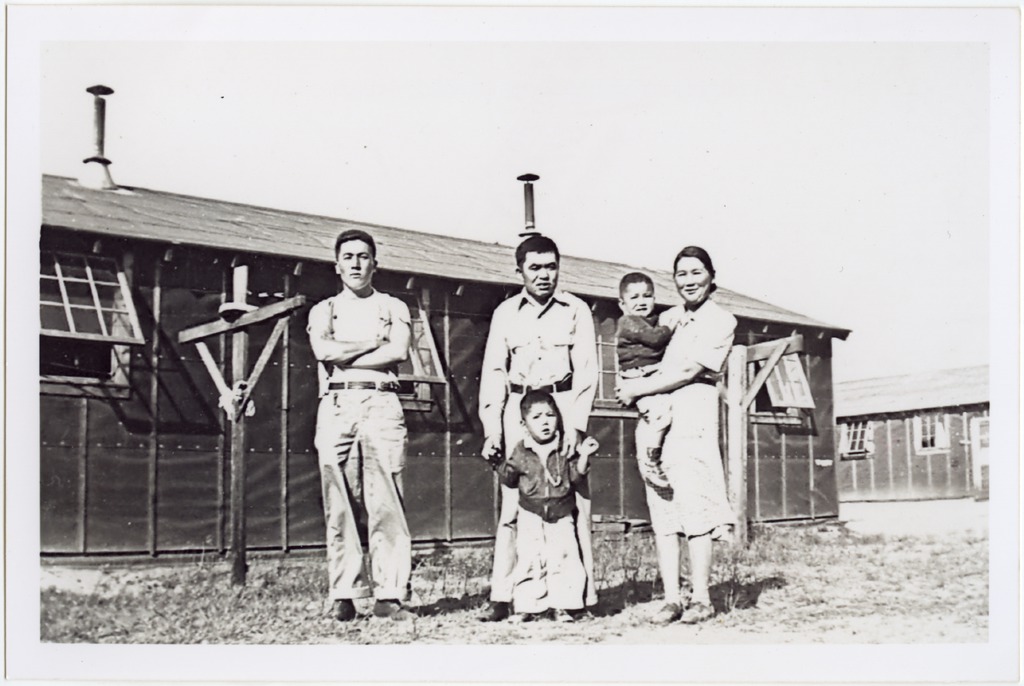April 26, 2019
It seems like more people are talking about Japanese American history than ever before. As it’s become increasingly relevant to our country’s current political moment, the Japanese American story has started to pop up in some unexpected places, from podcasts and breaking news coverage to viral Reddit threads and popular TV series. But the language used to tell this story hasn’t quite caught up with its newfound reach. While more people know what happened to Japanese Americans during WWII, most of them are still learning that history through decades-old euphemisms that diminish its harsh realities.
Today, we can recognize the euphemistic language used by government officials and military leaders during WWII as deceptive — for one particularly egregious example, look to the Puyallup Assembly Center, or, as it was dubbed in 1942, “Camp Harmony.” But the textbooks and major news outlets where many Americans hear this story for the first time have yet to update their terminology accordingly, perpetuating that deception. Words matter—not just for the sake of accuracy, but for a future free from the kind of violations and violence that demand euphemisms in the first place. To avoid repeating the mistakes of our past, we must be able to see them clearly.
It’s with that in mind that we’d like to share our updated terminology guidelines for discussing the experiences of Japanese Americans during WWII. We encourage you to join us in advocating for more honest, accurate language and share these guidelines with your local news editor or school board.
Forced Removal vs. “Evacuation”
In early 1942, Japanese Americans were forcibly removed from the West Coast and forbidden to return. The government called this an “evacuation,” implying the forced move was a precaution for Japanese Americans’ own safety, as in a natural disaster. In reality, this was a targeted exile of a single ethnic minority—carried out by armed soldiers, enforced by lawmakers and elected officials, and motivated, in part, by a desire to reap economic gains from the farmland and property Japanese Americans were forced to leave behind. “Exclusion” and “mass removal” are therefore more apt than euphemisms such as “evacuation” and “relocation,” because Japanese Americans were expelled from the West Coast and subject to arrest if they returned.

Incarceration vs. “Internment”
The commonly used term “internment” fails to accurately describe what happened to Japanese Americans during WWII. “Internment” refers to the legally permissible, though morally questionable, detention of “enemy aliens” in time of war. There were approximately 8,000 Issei (“first generation”) arrested as enemy aliens and subjected to what could be described as “internment” in a separate set of camps run by the Army or Department of Justice.* This term becomes a misleading, othering euphemism when applied to American citizens detained by their own government; yet two-thirds of Japanese Americans incarcerated during WWII were U.S. citizens by birth and right.
Although “internment” is a recognized and widely used term, we encourage the use of “incarceration,” except in the specific case of Japanese Americans detained by the Army or DOJ. “Detention” is used interchangeably—although some argue that the word denotes a shorter period of confinement than the nearly four years the camps were in operation.
*A smaller number of Nisei, mostly Kibei and mostly in Hawai`i, were also swept up in the DOJ internment system.
Japanese Americans vs. “Japanese”
Media outlets and other sources often refer to the more than 120,000* people of Japanese descent imprisoned by the U.S. government during WWII as simply “Japanese”—but this both erases their American identity and conflates Japanese Americans with Japanese citizens in Japan. The wartime government employed this strategy itself, inventing the orwellian term “non-alien” to describe Japanese American citizens in public documents.
The Nisei (“second generation”) were U.S. citizens born to Japanese immigrant parents in the United States. Many had never set foot in Japan. Their Issei parents were forbidden by discriminatory law from becoming naturalized American citizens, but by the 1940s most had lived in the United States for decades and raised their families here. Most had no plans of returning to Japan, and would have become naturalized citizens if allowed. By birth or by choice, Japanese Americans were just that—American.
*The oft-cited “120,000” figure comes from the War Relocation Authority’s official statistical compilation, The Evacuated People, which cites a total of 120,313 people in the WRA system. However, including DOJ/Army internees and those who were held in “assembly centers” but resettled before being transferred to WRA custody, that number is closer to 126,000.
Concentration Camps vs. “Relocation Centers”

There is still some debate over the most appropriate terminology for the camps where Japanese Americans were confined during WWII. At first, Japanese Americans were held in temporary camps the government called “assembly centers”—facilities surrounded by fences and guarded by military police. This term is clearly euphemistic in nature, as the “assembly” was carried out by military and political force. Therefore, we recommend its use only as part of a proper noun (e.g. “Puyallup Assembly Center”) or in quotation marks for specific references to this type of facility.
Japanese Americans were later transferred to longer-term camps which the government called “relocation centers.” (Some officials, including the president, also referred to them as “concentration camps” in internal memos.) Despite the seemingly innocuous name, these were prisons—compounds of barracks surrounded by barbed wire fences and patrolled by armed guards—which Japanese Americans could not leave without permission. “Relocation center” fails to convey the harsh conditions and forced confinement of these facilities. As prison camps outside the normal criminal justice system, designed to confine civilians for military and political purposes on the basis of race and ethnicity, these sites also fit the definition of “concentration camps.” As such, Densho’s preferred term is “concentration camp” (e.g. “Minidoka concentration camp”). We do also use other terms, such as “incarceration camp” or “prison camp,” but urge the avoidance of euphemisms such as “relocation center” and “internment camp.”
Our use of “concentration camp” is intended to accurately describe what Japanese Americans were subjected to during WWII, and is not meant to undermine the experiences of Holocaust survivors or to conflate these two histories in any way. Like many Holocaust studies scholars, we believe that “concentration camp” is a euphemism for the Nazi death camps where millions of innocent Jews and other political prisoners were killed. America’s concentration camps were very different from Nazi Germany’s, but they, and dozens more historical and contemporary examples, do have one thing in common: “people in power removed a minority group from the general population and the rest of society let it happen.” [1]
Words Matter
Since the 1970s, Japanese Americans, historians, educators, journalists, and others have increasingly advocated for the use of terminology that more accurately represents this history. Rather than repeat the euphemisms used by the U.S. government and other defenders of WWII incarceration, we encourage individuals to think critically about the impact of words like “internment,” “relocation,” and “evacuation.”
In the words of Redress hero Aiko Herzig-Yoshinaga, “words can lie or clarify.” [2] When we use language that distorts the past, we lose our ability to recognize patterns of repeating history. But words that impart truth and understanding can help us avoid repeating those same mistakes today.
—
Adapted from Densho’s terminology guidelines: https://densho.org/terminology/
[1] Excerpt from text accompanying the 1994 Japanese American National Museum exhibit, “America’s Concentration Camps,” written by representatives JANM and seven American Jewish organizations. See JACL’s Power of Words Handbook, pp 12-13.
[2] Aiko Herzig-Yoshinaga. “Words Can Lie or Clarify: Terminology of the World War II Incarceration of Japanese Americans.”
Densho’s terminology conforms with the “Resolution on Terminology” adopted by the Civil Liberties Public Education Fund (see http://www.momomedia.com/CLPEF/backgrnd.html).
See also: Roger Daniels, “Words Do Matter,” a 5-part article on the Discover Nikkei website.
[Header photo: Japanese American family posing outside of barracks in Tule Lake concentration camp. Courtesy of Kazuo and Susan Takeda.]
